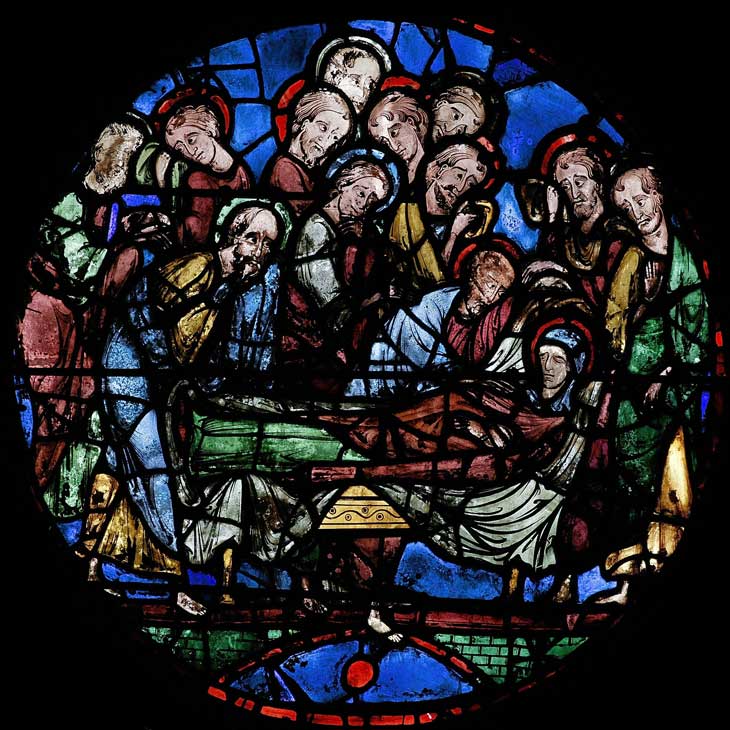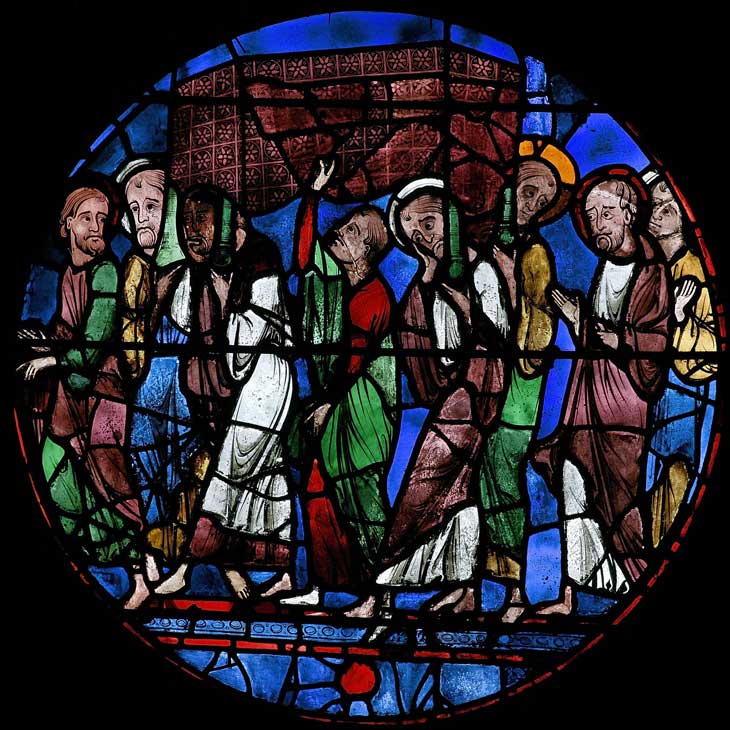… or ‘A long analysis of an almost insignificant detail’.
Taking the time to answer these questions means venturing into the world of the 13th century through ‘the very small end of the spyglass’: its aesthetic choices, its symbolic choices, its clever master glassmakers. Come along with us…
The narrative stained-glass windows of Chartres are based on a perfectly established framework of expression, characteristic of 13th-century art and adhered to in the strictest possible manner:
On the one hand, the borders, as well as the background of the stained glass, which takes on the appearance of a continuous tapestry, using both geometric and vegetal motifs. Often, the background sets the tone, the mood, you might say.
On the other, panels explaining the various scenes in the story, in the manner of our comic strips. These panels, of various shapes (circles, lozenges, quatrefoils…) are systematically delimited by one or more colored fillets, and generally correspond to spaces circumscribed by the metal frame. They’re the ones we look at first…
Between these two ‘zones’ of a stained-glass window, the separation is totally hermetic – which is not without surprise when one considers the habits of artists a few decades earlier. The ornamental margins never contain a single historical element. Conversely, there is nothing in the scripted description of ‘history’ that is purely… decorative. It’s as if the artists were obliged to include details that have a purpose – at the very least, a functional reason to exist. The ornate line becomes a ‘floor’ in the same way as the bridges or arches we often see at the bottom of the panels; the tree becomes a ‘landscape’ in the same way as the architectural detail becomes a ‘building’. A few very rare shrubs can be seen in the bottom corner of some panels, totally out of context, whose sole purpose is to ‘furnish’ the voids beneath the floor levels. On the other hand, there are no gratuitous geometrical signs, which would only respond to ornamental concerns.
If we methodically classify the details depicted in all the stained-glass windows in the lower bays, this rule proves to be unbreakable – with only one real exception, which is worth taking a closer look at.
The “Glorification of the Virgin” stained glass window is located in the south aisle of the cathedral. We’re concerned here with the stained glass axis, which alternates quadrilobes and large circles. We need hardly remind you of the importance of the axis: it usually allows us to get to the heart of the symbolic meaning, to identify – in other words – the second/third level of reading.
Starting from the bottom, in the first circle, we’ll see that the horizontal ground is ensured by a ‘bridge’ stretched between the edges:

Dormition of the Virgin Mary, Glorification of the Virgin Mary stained glass window ©NDChartres-fonds Gaud
In the second circle, a decorated line acts as a floor:

Funeral procession, Glorification of the Virgin Mary stained glass window ©NDChartres-fonds Gaud
In each case, the empty space is occupied by a… red dot.
It’s easy to understand the master glassmaker’s intention here, as he is committed to an archaic logic that abhors ‘voids’. To fill this color space, he uses the simplest means at his disposal: the ‘spot’, with its red/blue contrast. In so doing, he also materializes the ascending line of the glass roof (which, after all, features the Assumption…).
In fact, these dots are an irresistible eye-catcher. They are, we repeat, a curious exception to the thousand or so narrative panels.
To be continued…